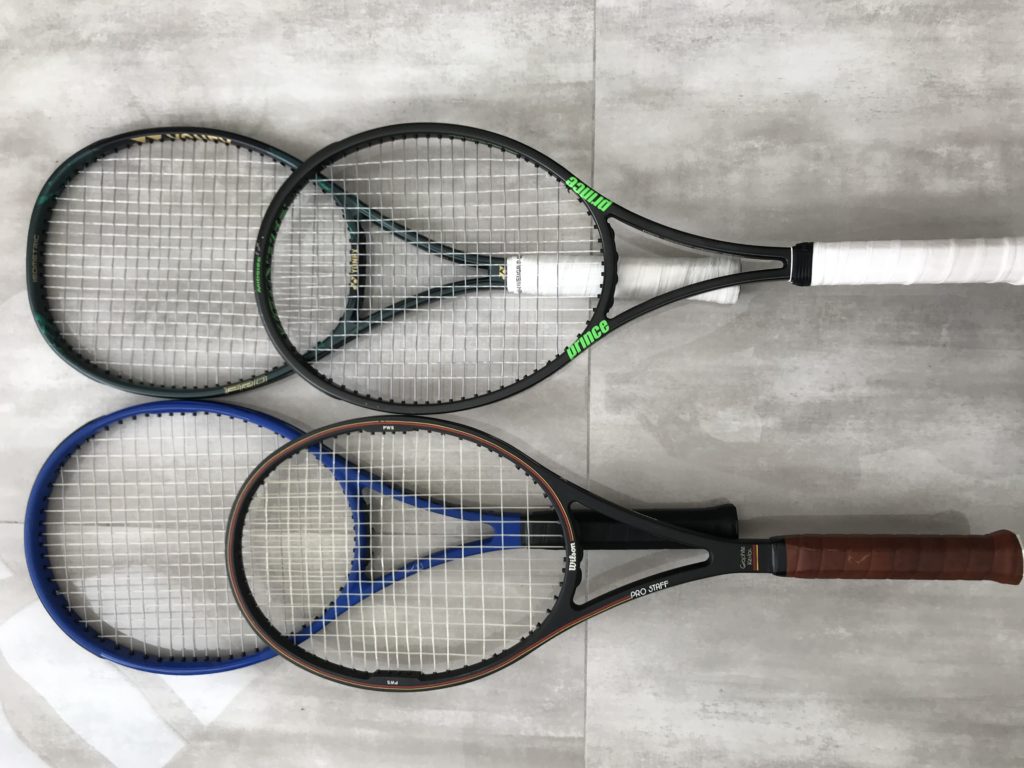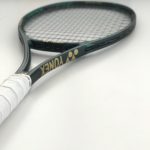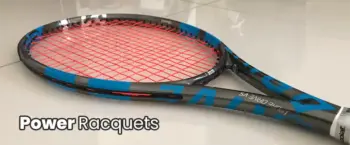I have been suffering from both wrist and elbow pain lately. Not sure what caused it, but it has made me test more arm-friendly strings.
Arm-friendly strings
The most popular string these days are stiff poly strings that offer good control, durability, and spin. They only have one real downside – they are not arm-friendly strings. And this is in part why we are seeing an increase of tennis elbow, wrist and shoulder injuries these days (it also has to do with stiffer racquets of course). Not that long ago most tennis players used only natural gut, synthetic gut or multifilaments, but with the increase in powerful racquets and the transition to a spin-heavy game, advanced players needed a more controlled response. Gustavo Kuerten was the first pro to actually use poly strings when he started using Luxilon Alu Power Big Banger more than 20 years ago.
To understand more about racquets and strings, you can check out our course, e-book or consultation service. If you want to purchase strings, please consider checking out the selection of strings from our friends at Tennis Warehouse, Tennis Warehouse Europe or Tennis Only.
But that does not mean that all professional and advanced players use full beds of poly strings, many pros such as Roger Federer, Novak Djokovic, and Andy Murray use so-called hybrid setups with natural gut or a synthetic gut/multifilament paired with a poly string. This creates a softer, more powerful response that is better for the arm, but also gives you a bit more control and spin than a full string bed of gut/multifilament.
Most recreational players should not use poly strings in my opinion. Instead, they should look at more arm-friendly strings and string setups such as hybrids or a full bed of multifilament and synthetic gut.
Make sure you can play more tennis
Most arm-friendly strings and string setups are not as spin-friendly as a full bed of shaped poly strings (like Solinco Tour Bite for example), but with the right technique you can generate spin anyway. And unless you are really a serious competitive player, saving your arm is better than getting that extra percentage of spin. It, of course, depends on the player. If you are a clay court grinder who likes to generate spin and pace from the back of the court with a full western grip, then a poly might be your best option. But many players that use poly strings, are doing themselves a disservice and risking injuries down the line.
I am becoming a big fan of hybrid setups myself. I have tried a bit of everything and I am currently testing a Mantis Synthetic Gut in the mains and various polys in the crosses in the Yonex VCORE Pro 97 HD and the Prince Phantom Pro 93P 18×20. It is a really comfortable string setup (even at a higher tension) that gives me some extra power and feel, but the addition of the poly string adds some control and durability. One of my hitting partners is a pretty advanced player but uses a full bed of HEAD Velocity MLT 1.25
as his string in a Volkl V-Sense Tour 10
. He hits hard, but flat which makes the string last long.
Why not try a more arm-friendly string setup?
If you have no concerns around arm-pain, tennis elbow or wrist injuries, this post might not be for you. But if you are a player who values comfort and wants to play the game without long injury periods, I can really recommend looking into a softer string setup. There are so many strings out there these days, everything from softer polys to hybrids to synthetic gut and multifilament strings. I will keep testing new strings of all brands, shapes, and sizes, but for my own game, I am pretty sold on the hybrid setup. Hopefully, it will help me to stay away from injuries in the future, but I also like how good it feels on impact. More to come on this topic soon!
What string setup are you using? Are you happy or do you have any concerns?
















I currently play the Clash 100 with Wilson Spin Effect Hybrid. I have some modified Head Graphene Touch Extreme Lite frames (full silicone in handle and leather grip) that play nice with Head Velocity MLT. I think Velocity has good control and nice spin for a multi. I think it works well with Lynx in a user friendly hybrid. You can use either in the mains depending on your needs. I also have a couple Wilson Ultra Tour 97 strung with a full bed of multi. These setups allow me to play 4 times a week pain free. Good luck with your recovery.
Thanks! Great to hear a lot of people enjoy the Velocity MLT!
I agree with Jerry. After a bout of severe tennis elbow I switched to a full bed of Head Velocity MLT in my Wilson Ultra Tour 97. I find spin adequate and my arm got better.
I had TE before, I switched racquets, playing with beast 98, with thinner polys, alu power feel 1.20, red code wax 1.20 and hyper g 1.20 , while playing with max 52pounds I’m not feeling any discomfort.
I play with 16g Natural Gut in the mains from Natural Gut Wholesale (NGW) and a monofilament poly in the crosses. I’ve tested it with NGW’s 17g, and Gamma’s 17g poly, but I think my favorite setup so far is their cheap gut and Hyper G in the crosses. That’s the setup I strung up for my wife in her Pure Aero. Also, the customer service of NGW is exemplary. Definitely give them a try.
I’d love to hear your thoughts on tensions in hybrid setups. The opinions differ here and my stringer and I don’t agree. He suggested that mains should be strung tighter than the crosses due to the difference in length of the actual string. I, however, am of the opinion that the stiffer poly should be strung at a lower tension due to the lower elasticity. i.e. when strung tighter, the softer string (multi or synthetic gut) will support and harmonise better with the poly.
I’ve played around with ALU Power Soft mains and Babolat Origin crosses in my HEAD Prestige pro stock and two older Radicals (LM and i.Radical). I got great results with 51/55 lbs in a 16×19 racquet and 50/53 in a racquet with a tighter 18×20 pattern.
Hej Oskar,
I generally agree with you each string should be strung according to their characteristics. I like a poly strung around 24 kg in the crosses and a gut (syn gut or multi) strung at 25 or 26 kg in the mains. I think this is what works best for me. But I can also do a poly in the mains and a multi in the crosses, but I prefer similar tensions, more according to the string and not the length of the string. Sounds you have a good setup going!
Cheers / Jonas
Cheers / Jonas
With this topic you have hit my button for 2019. I had my first ever case of tennis elbow in January, which was minor and went away on its own, but then I incurred a worse case in March. I tried to recover on April and May but after not making much progress by June decided to stop hitting backhands (TE is caused mostly by backhands, especially single handed backhands) while doing some stretches and exercises from ytube. In August I did not play at all, and by September I could play again almost pain free.
I am also softening my gear. So I added the Clash to my arsenal, and I am experimenting with softer strings.
First I tried the Yonex Rexis multifilament. Though it was comfortable, it notched quickly and I would not recommend it.
Since multifilaments and natural guts are chewed up or sliced by sharp, shaped polys, it could be that with these strings in a hybrid one should only use round polys.
There is a debate between some people who say spin is better with sharp shaped polys, and others who claim that spin is enabled more by the sideways movement and snapback of strings, and smooth round polys excel at that. I think that both of those factors enhance spin, and so ideally what one is looking for is a low coefficient of friction from string to string, and a high coefficient of friction from string to ball. Normally these two things do not exist together, hence the challenge for string engineers.
Looking at the TW string database, one can find this data and order strings by these factors. One can observe that multifilaments and natural guts generally have a higher string-to-string coefficient of friction (ie. not good for spin) than polys. It turns out that the multifilament (or multifilament-like string) with the lowest coefficient of friction with other strings is the little known Babolat Origin. Origin is actually not a multifilament, but a monofilament made of polyamide which is approximately as soft as a multifilament.
So the Origin is what I am trying now.
Other multifilaments that I find interesting and worth a test are Tourna Quasi Gut Armor and Tourna Synthetic Gut Armor. These are multifilament and synthetic gut strings respectively combined with polyester strands so that they are soft like these two types but have some of the control and ball grip of a poly. Sort of like a hybrid in one string. I think some other string makers have similar combinations.
There is another debate with hybrids about whether the multi/gut or the polys should be in the mains or the crosses. It seems that more and more pros (incl Federer for example) are putting the gut in the mains and the poly in the crosses. The string that is in the mains dominates the playing characteristics of the combination.
I would add to this debate one factor: that in terms of the amount of stretch, it makes more sense to put the multi (or the gut) in the crosses and the poly in the mains. This is because the crosses, as a proportion of their length, stretch more than the mains when you hit the ball. Since polys are less stretchy (and retain whatever stretch they have less than multis and guts) they should go in the mains and the stretchier guts and multi’s in the crosses. But that is just one factor in the decision.
So there are my two cents to add to this discussion at the moment.
Best multi is without any doubt the Isospeed control/professional (same string in different gauge) It plays very much like a natural gut and it have good durability.
My personal preference for a hybrid is Luxilon Alupower soft in the mains and a natural gut in the cross.
Hi Jonas,
Great post! Do you have a preference or recommendation of which strings to use for the mains and which to use for the crosses? I remember reading about hybrid setups in the past, but I don’t recall what the pros and cons are for a multifilament/main and poly/cross setup, or vice versa.
Thanks!
A nice hybrid combination is Laserfibre Supreme 2.0 (multi) for the Mains and Head Lynx (soft copoly) for the crosses.
I’ve had wrist problems in the past so I have to be careful.
update: after testing, the Babolat Origin is not as soft as I thought. It is good for allowing other strings to slide and snap back, but it is not as comfortable as the multis I have tried.
I spent some time geeking out with the TW string database, and here are some other multifilaments and synthetic guts that I would like to try as crosses:
Tecnifibre Multifeel 17 black (the black appears to have a lower coefficient of friction with other strings than the natural colour)
Gosen AK Control 17
Gosen AK Pro CX 17
in addition to some that others have mentioned here:
Head Velocity MLT
Isospeed Professional
in addition to the Tourna Synthetic Gut Armor and Quasi Gut Armor mentioned above.
what kind of tension you use with syngut and pole crosses?
I use 24-25 kg on the syn gut and 23-24 kg on the poly.
I played with hybrid for years: Mikronite Multifilament Mains 26kg / AluPower Rough 25 Crosses. This combination lasts for me , 1 month before it breaks.
After i switch from multifilament to Natural gut mains / AluPower Rough crosses… I can say loud and clear… Nothing compares to Natural gut, and there is no Multifilament that comes even close to NG…so all that marketing that multi playes like natural gut is just one big lie…… they did not tell in what specific WAY that strings plays “like” NG…… BUt…… when you try natural gut , there is no back!
And yes….. Mains should be lets say 25-27, and crosses 23-25…… NEVER , EVER string poly on crosses higher then Mains…… because, Mains, if you use multi or gut, MUST be in higher tension because of Material and elasticity of the mains…. not because of string lenght….
Hi, I’ve got more than 70 Head rackets (90% old Prestige….from the first model to the last …plus 14 prostock…among them the PT57A) so I can say to have a large experience about strings and tension depending by each model, but generally when I used on my frames the Babolat VS Touch 1,30 natural gut combined with Tecnifibre X-One Biphase 1,24 my racket seems to be a part of my body …something like a longer arm specially on thin and heavy frames (I play starting minimum from 315 gr up to a maximum of 335 gr) and the never had problem regarding tennis elbow until today (considering that I usually play 4 times in a week….)
This is a great post. I have been battling a nasty case of TE and finally have made some headway as far as improvement. One big contributor was switching from a Babolat Pure Drive strung with Silinco Hyper G poly to a more arm friendly racquet. I am now using a Wilson Clash and am testing various multi’s. So far I have had good luck with Wilson Sensation but really have moved on to Wilson NXT and hopefully some Technofiber NRG2. I definitely like a 17g string and both have improved my arm tremendously. I love seeing what others are hitting with !!
Hi all, I hope it’s okay to add to an aging (but great!) post. Looking for better elbow comfort I’ve been experimenting with Multi/Poly hybrids and have had truly (frustratingly!) mixed results with Velocity in the mains and Hyper-G in the crosses. I say “mixed” because the initial result was fantastic–controlled, predictable power with great, leaping, topspin (playing a Microgel Radical OS, 54/50lb) and perfect elbow comfort. Unfortunately, once the Velocity began notching (maybe the 3rd match), friction between the strings shot through the roof and took the spin and predictability with it. It seems Velocity has a slippery coating that wears away exposing a much stickier interior. As a point of comparison I strung another, identical racquet strung with with 17g Hyper-G in the mains and TNT2 in the crosses resulting in lower power but maintained spin and control…unfortunately at the cost of elbow pain coming back. Aaargh! I’m frustrated! I would love to hear your ideas for a hybrid setup that keeps its playability for more than a few hours!
There is a basic rule about Poly strings and is clearly written on the strings packages, Poly strings are recommended to be strung 10/15 % with less tension than a regular string just that will help to remediate most of the arm, wrist, shoulder problems we see very often, and second Poly strings have a very short life basicaly 8/10 hours, after that they become dead and lose all elasticity. (some even get dead in about 3 hs.)
In my experience the Poly with longer lifespan is Luxilon 4G that last alive about 23 hs, all the others get dead in half that time or less.
Polys are for the person looking for control thru spin , and the player whom pop strings in 2/5 hours . Mr Nadal plays with 15L string he gets control because the thicker gauge first and the properties of Poly he employs.
Hope will be more push from the manufacturers to help with this issue and avoid some many injuries.
I play with the Clash 100, originally loved Technifibre x1 bi phase, but have now switched to multi feel due to price. They are great.
Have strung for TE and arm pain to several people and myself (first time in 30 years). I tried many of the strings mentioned above myself, also with various tensions and like Johnson found better to have more tension on multi than mono polys (including soft polys).
My honorable strings are IsoSpeed Cream and Control, and Tecnifibre Multis and 4S poly for spin.
I use 632cm^2 racquets with no more than 64RA declared at 52DT. Full swing classic strokes all court.
Yeah those Isospeed strings are great for the arm!
how long does your synthetic-gut main / poly cross last?
I play Kirschbaum pro line II evolution in the mains 1.25mm and Head RIP control 1.30 mm in the crosses. My elbow problems have clearly improved compared with using a full bed of poly.
if string pattern is 16*19, 16 is the main right? for hybrid, why do many people suggest to use multifilament? in my opinion, main using polyester is better to create more spin right with less tension than cross multi?
I’m totally with you regarding arm-friendly strings. However, I don’t understand why hybrid is necessarily arm-friendly. I assume hybrid just means 2 kinds of strings for mains and crosses. They could be too stiff! Maybe I’m missing something.
I am experimenting with 18 g strings (for spin). I can’t really afford natural gut, but I’m trying to get the softness of gut — perhaps with the NXT POWER 18 or the Technifibre X-ONE BIPHASE 18. Does anyone have thoughts about these, and could you recommend a hybrid that would also be worth trying, and tell me the reasons for doing so?
Thanks,
Gordon
Thanks for all the comments, thought i would contribute. Suffering from minor TE now , i was using a Clash 100 with yonex polytour pro (best string if you want spin and pocketing, but loses tension quickly so will have to cut it after 6-8 hours) and have tried at least 20 different string combinations. I was looking for spin, feel, comfort and tension maintenance and think i have finally found the right combo. Please bear in mind that different string setups work differently in different rackets. But for me, in the Clash, this works amazing.
I use the Triax 16 as the main strings and luxilon 4 g (17 gauge) as the cross and it plays amazing. (almost like a full bed of yonex poly tour poly) I string at 52/50 and it lasts about 15-20 hours. Importantly, the tension lasts the whole way through. If you are still searching for a good hybrid combo, please try this out.
A couple years ago I got TE during a solid month of training with a new PS97 strung with Volkl Cyclone / SP Tornado. Have fully recovered thanks to Theraband flexbar and a switch to weighted up Dunlop CX 200 tour with Klip Legend mains and Tier One Ghostwire cross 55/50 plus some coaching for smoother mechanics and timing. This hybrid is a good comprise for me giving comfort as well as some ball pocketing and spin. Currently I am trialling lighter, stiffer frames to help my singles play but will not be going back to full bed poly any time soon.
I have been hybrid setups previously in a Vcore 95 2021 and Ezone 2021 7th ed (65 RA) for the last few years and have experimented with many setups and tensions and have learned some hard truths.
Ideally its about obtaining the best characteristics of both strings without sacrificing them by the getting the tensions wrong and the fact you can save money using natural gut if its on the mains strings which I will explain later.
A lot of people will say always put gut or multi or crosses or visa versa, I would say both are not the same as gut gives you other advantages that multi does not on the mains as noted below, it depends obviously on which strings you use and what you want. Honestly I would not wast my time with synthetic gut, just use a multifilament if you cannot buy natural gut on sale.
For a soft setup you want the softer string son the mains which is either the multifilament of natural gut, but in order for it to not lose too much control its needs to be string at a higher tension than your normal poly, most of you would already know this.
Although you get more power and and a softer feel you will still lose a lot of control even strung at a higher tension say 52lbs compared to a poly on the main at 48lbs. In order to make up for this lack of of control its best to use a stiff poly in the crosses but strung at a lower tension say mid 40s.
There are loads of advantages with this setup.
1. the string will provide loads of control as its the stiffness that mainly provides more control and mid 40s is not low enough to effect this negatively.
2. The stiff poly it will not be harsh on your arm strung in the mid 40s and the gut or multifilament will provide most of the softness.
3. the lower string tension creates more string movement for snap back that creates loads of spin. ( be careful not to use. a shaped poly as a cross with natural gut on the mains as this will cut int the string).
4. If using natural cut it will hold it tension easily over a year provided you keep it away from water and very high humidity! A stiffer cross string also holds its tension way better than softer polys e.g. Classic 4 G or RPM blast.
5. Stringing at lower tension also lets responsive stiff strings like 4G and RPM blast perform best where they put energy by back into the ball, which means more power in addition to the power from the gut or multi.
6. Stringing will cost less if you use gut in the mains because on a stringing machine the stringer only needs to change the crosses being the poly which goes dead after a while e.g. 10 hours of play. This means less strings used (half a 12m pack) and half price stringing unless your stringer is stingy.
I have used by gut in the mains for three comps this year and it has held tension just fine and not worn out too much.
Note: the stringer cannot do this if the gut is on the crosses as the tension on the frame will cause problems when the mains are cut out.
Of course you can put the multi on a cross if you want even more control and use a poly on the mains, it will just be a lot less soft which is not great for stiff racquets (anything 65RA and above) unless you use a softer poly like Yonnex poly pro tour morover, It does not matter the mains as a poly will be a much lower tension then the cross (multi) , as long as there is a difference between the two strings there will be more snap back to create spin. But as noted before best not put the the natural gut in the crosses as when it comes to change strings when the poly in the mains goes dead you will both strings cut out.
There are people who say the mains create more spin or the crosses, visa versa but the Tennis Warehouse University tests have proven the difference is very minimal as the swing path makes both strings move regardless.
Here are some classic set ups:
1. Natural gut mains 51 lbs, crossed with RPM blast (round) 46 lbs (my current setup up on a Vcore 98)
2. Gut as above, crossed with Luxilon 4G (classic) 44lbs
3. Gut as above, Luxilon 4g (rough) 46lbs
4. Velocity MLT mains 52lbs, Head Lynx Tour crosses 4lbs
Velocity is a great string. However I find that it breaks after 3-4 hours of hitting.
Knowing this is an ancient post…
I tried all kind of set-ups in both Babolat Aero and Wilson Clash (both 100 and Tour) rackets. In my view, the best option by far was a combination of Wilson Revolve in the crosses and Babolat VS in the mains. Although VS is expensive, it lasts very, very long and delivers good economics. In combination with Revolve, which is a very slick string, the VS does not notch.